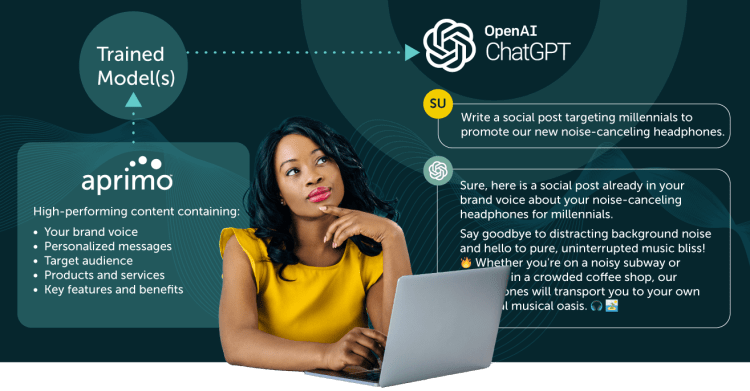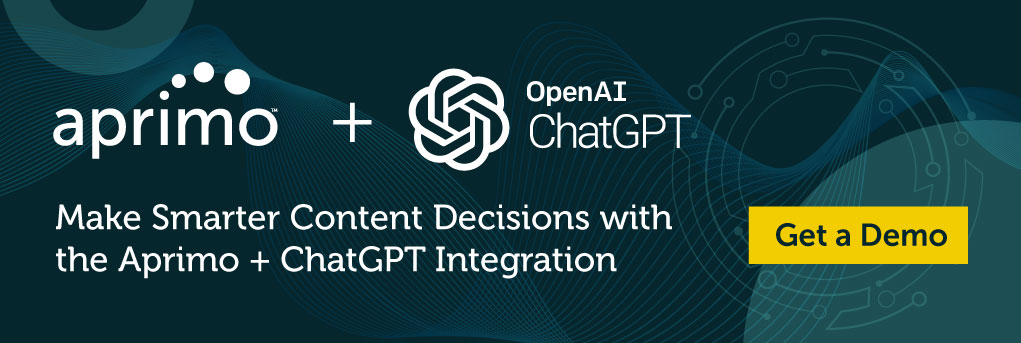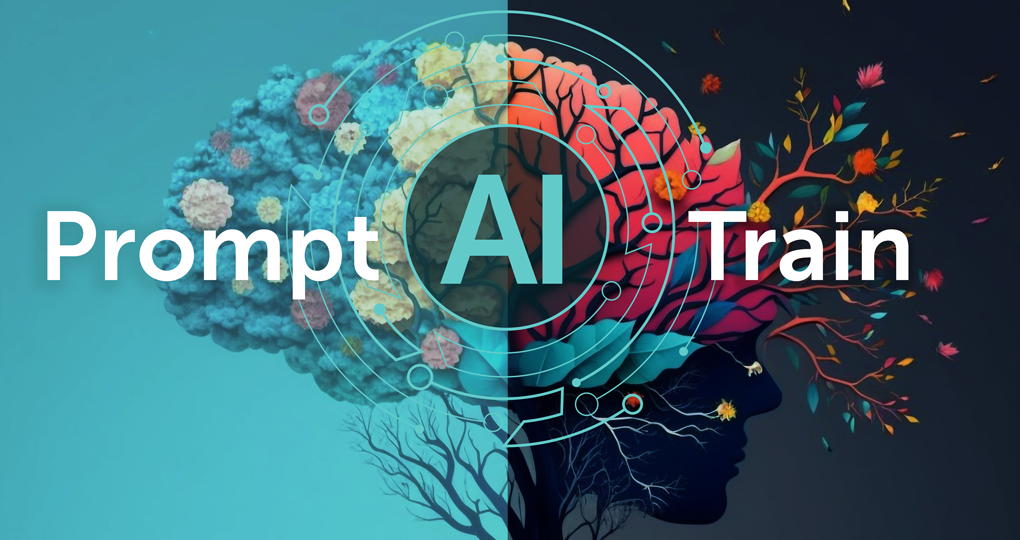Welcome to part three of the Aprimo Generative AI Guidebook! If you missed parts one or two, you can find them here:
- Part One covers how you can start managing the abundance of content being created safely within Aprimo today.
- Part Two covers how you can leverage Aprimo metadata to help guide your users on how to create better content via generative AI like ChatGPT using Aprimo data today.
In part two, you could see how more specific prompting can get you much closer to brand-compliant messaging from ChatGPT. While this is a great way to start giving content creators guidance to improve output from a standard AI tool, we can unlock the next level of content creation by exploring what is possible with training.
In part three of the guidebook, we’re going to take the concept of part two – how to get better, more on-brand messages out of generative AIs like ChatGPT – and talk about how training can be the magic that lets you get brand-compliant content out even faster and more efficiently.
Optimize Generative AI Content Using Aprimo
Today, when you fire up a ChatGPT session and ask it to generate some content, it doesn’t know anything about your business. ChatGPT is trained on a public domain dataset from 2021 – so whatever you do ask it about your business, it might have learned from your public internet presence from 2+ years ago!
But – what if you could fire up a ChatGPT session, and it already knows your latest products and services and can speak in your current brand voice? That would make it far, far easier for your marketers to get useful output out of GPT fast – and take you towards the highest level of automated content generation. This is where training comes in.
Training vs. Prompting
As opposed to prompts, which is the text you give to a generative AI tool to ask for a specific output, training helps a generative AI model by pointing it to a set of content to learn from and influence its output by. There are many ways to train an AI model depending on your use case, but no matter which method you use to train, the goal of the output is the same – to change the generated output without requiring the user to be incredibly specific with their prompts. While you can get a lot of valuable output using prompting alone, teaching people how to prompt effectively can be challenging. By training, you make it easier to get the output you want without needing to create sophisticated prompts. This will reduce the time it takes for a content creator to get AI-generated content that’s still compliant. Since generative AIs tend to charge based on how much they take in and produce, reducing the amount of chatter with them can not only lead to better output faster, but it can also keep costs under control.
Training A Generative AI Model Using Aprimo
First, you identify a set of content that you want to use to influence the output. This content should be as close to ideal as possible – perhaps this is the content in Aprimo that is most highly engaged with, measurable by Aprimo’s Content Return on Effort feature sets.
Second, you ask GPT to pull the copy from that content to learn from it and set up a trained model (or models) based on your existing content. Training can take a varying amount of time and money depending on the volume of content you provide, so it’s important to be able to identify the right set of content to train on.
Once training is complete, content creators can spin up a ChatGPT session that knows what high-quality, brand-compliant content looks like – thus making it far easier for them to stay on message.

Combining Training And Prompting
Prompting and training aren’t mutually exclusive, in fact, they can be used in tandem for even greater effect. Once you’ve trained a GPT model to understand what good content looks like and what your brand voice is, chances are your users will still use prompting to flavor the output according to a specific context. This could include a particular offer, something personalized for a specific persona, or messaging for a targeted campaign. While training will help GPT recognize the products and services you offer and the personas you target, as described by you – prompting will then help content creators shape the output.
As an example, you can train GPT to understand that an IT buyer would care about security, scalability, APIs, and the benefits that help them do their job. Then, a content creator can ask GPT via a prompt: “Can you write me some copy for product X targeted at IT Buyers?” – and instead of GPT using training data from public domain content to understand what Product X is and what an IT Buyer cares about – it can use your content instead to influence that, and be much more likely to stay on brand message.
Flip Brand Compliance: Generate On-Brand Content Upstream
Another aspect to consider is that today you are likely spending a lot of time and effort to ensure brand compliance with human or AI-powered content being created. As you train your generative AI models to start producing more on-brand content, however, you can reduce the number of reviews needed. While it’s unlikely in the short term you will get perfectly compliant output every time, you must start learning what trained generative AI models can do for you today and refine your training approaches. Failing to do so will force you to spend a lot of time reviewing AI-generated content when you should be moving towards generative AI output being more on-point on initial creation instead of increasing your compliance review burdens.
How To Navigate The Complexity Of Training
Jumping into training is certainly a step up from using vanilla GPT and prompting – but it may unlock significantly more potential and scale your content creation with a much higher maturity level. In a few years, the top brands will likely have custom-tailored GPT models ready for their content creators to level-up content creation like never before.
As outlined above, you need two things to get started: a pool of great content and the ability to train.
But there are some challenges that need to be addressed along the way. For example:
- Should you create one model trained on all your content, or consider separately trained models for different business units, products, or services?
- How can you pair training and prompting in the most effective way possible?
- How do you phase out old content that is no longer brand compliant when training?
- How do you learn and iterate rapidly to unlock value fast, then scale to your broader organization?
Aprimo can help you navigate these new challenges by working with experts at your company. We can help you pull the appropriate sets of content from Aprimo, advise on training your own GPT models no matter where they are hosted, and help you get closer to brand-compliant generative AI output, one step at a time.
This series of posts aims to provide you with a practical and straightforward plan to immediately start leveraging the power of Aprimo, GPT, and other AI tools for valuable outcomes. Stay tuned for part four to continue unlocking the secrets of generative AI and how it can impact your business today.
Have you heard about our new ChatGPT integration? Check it out here!



